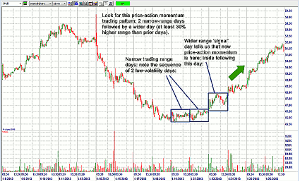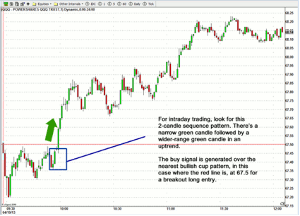Knowing how to spot and trade strong momentum trade signals can help avoid false breakouts while trading the best patterns in the markets, says veteran trader Ken Calhoun of TradeMastery.com and DaytradingUniversity.com.
In this third and final article in the series, we’ll take a closer look at how to use specific price-action momentum signals to identify emerging breakouts. In our earlier articles, we looked at “wide range” candles, MA crossovers, and the Wilder’s average directional index (ADX) to quickly filter through charts. As we examine strong momentum entry signals, one key concept to keep in mind is that we’re now looking for charts that are showing increasing momentum and price action, so that we’re able to pull the trigger on strong trades that move after we enter.
Momentum Swing Trade Entries: “Three-Day Expanding Range” Pattern
Many aspiring breakout traders make the common mistake of avoiding entries following strong moves, in fear that the price will exhaust and sell down after they enter. Avoiding false breakouts while still having the confidence to enter strong breakout signals is an important skill to develop.
One way to potentially minimize false breakouts is to look for expanding-range moves, in which the daily trading ranges are gradually increasing over a multi-day timeframe (such as two to three days in a row, where the daily high-low trading ranges are gradually increasing, indicating institutional buying pressure.
In Figure 1, Sears Holdings Corp. (SHLD), this three-day expanding range is illustrated, for a swing trading entry pattern. The key is to look for trading entries on the day following a wider-range day, buying new highs after an initial breakout.
For pivots such as this one, it’s best to see a series of two consolidating narrow-range days followed by a wider range day. We define narrow range days as trading days in which the high-low price action is very similar, in this case 46.7- 45.7 = 1 point trading ranges, on 4/19/2013 and 4/20/2013, followed by a 1.5 point range on 4/23/2013 (48.0 – 46.5 = 1.5 points).
A wider range day is one in which the day’s high-low range is at least 30% wider than the prior day, as you can see in this example (1 point for a regular range day, compared to 1.5 points on a wider range day). Entry signals are generated just above this day’s high, for a continuation breakout swing trade, using a 1-point initial and trailing stop, for an entry signal 4/24/2013.
The rationale behind this approach is that by waiting to see a wider-range trading day following flatter price-action days, this tells us that institutional buyers are “tipping their hand” and are showing us they are net buyers of this instrument. As active traders, we can capitalize on this by simply buying new high breakouts after this three-day pattern is observed.
Momentum Intraday Signals: Two 1-Minute Candle Breakout Trades
Day trading exchange-traded funds is a popular approach to trading on strong momentum signals, especially during the recent market rally. In Figure 2 PowerShares QQQ Trust (QQQ), a day trading chart reveals a useful two-candle momentum entry setup that can be used by active traders.
The pattern to look for is a series of two 1-minute candles, of which the second one is at least twice the size of the first one. To help filter for false breakouts, it’s useful to add the requirement that we wait to enter until after price action has moved above the closest previous high, forming a bullish cup pattern.
In this example, that shows us that the “signal line” for a trade entry is at 67.5, which is at the top of a cup pattern following this two-candle sequence. The goal is always to filter out false breakouts, while capturing strong entry signals that are most likely to continue in our direction after we enter the trade.
NEXT PAGE: Creating a Momentum Trading Action Plan
|pagebreak|Clues about emerging strong price action can be found in the contrast, the comparison of what the size of the candles is telling us, minute after minute for day trades. When swing trading, we also look for emerging wide-range candle patterns combined with western trading signals as explained in the earlier two articles in this series.
Creating a Momentum Trading Action Plan
The goal is to look for entering at prices that are likely to attract additional buyers after we enter…so it becomes especially important to avoid false breakouts by avoiding questionable entries during choppy trading ranges, and selectively scan for the strongest momentum trading signals possible, to capture successful trades.
When developing a trading plan, the most important factors are risk management, entry and exit signals to use, and scaling into winning trades to leverage successful trading decisions.
STEP 1: Determine the maximum risk/drawdown you’re willing to take on any one trade. It is suggested that you make this a hard dollar cost figure or point value, not a “loss of chart pattern support”, since that can lead to too large stops. For example a .10-cent stop for day trades and a 1.0 to 1.5 point stop for swing trades is a professional traders’ guideline to consider.
STEP 2: Decide which entry signals to use, and how to scan for them. In this three-article series, we’ve covered some of the very strongest patterns, including wide-range candles, cups, Wilders’ ADX, MA crossovers, expanding ranges and more. Traders are encouraged to test out one or more of these, using stocks and ETFs priced $20-$70/share with at least 1.5 million shares/day minimum volume.
STEP 3: Use tight trailing stops and scale into (and out of) winning trades incrementally. For example it’s fine to close ½ of a 300-share swing trade once it’s moved in your favor by just two points; locking in a gain and letting the rest of the trade “ride” with a close trailing stop once it’s in the money, helps build confidence (and potential trading wins) by trading momentum entries correctly.
STEP 4: Look for lateral (same-sector) trading opportunities. For example our healthcare, biotech, and pharmaceutical sectors have been strong during the last several weeks. If trading just one or two instruments on momentum breakout plays, look for similar patterns for other stocks/ETFs in the same sector, for diversification and leverage.
STEP 5: Close out trades at first sign of price exhaustion. For day trades, if there are two red opposing 1-minute candles once in a position, closing out the trade on loss of support of the second red candle (or .10, whichever is closest) is an appropriate strategy. For swing trades, a loss of two-day lows (or 1.5 points, whichever is closest) is a good place to start exiting the trade.
Putting it all together into an easy-to-trade process is a key to trading effectively. Knowing how to spot (and trade) strong momentum trade signals can help avoid false breakouts while trading the best patterns in the markets. In upcoming articles, we’ll look at how to develop a step-by-step process for making effective trade decisions and more.
Ken Calhoun is a trading professional who has traded millions of dollars of equities since the 1990s, and is the producer of multiple award-winning trading courses and video-based training systems for active traders. He is a UCLA alumnus and is the founder of TradeMastery.com and DaytradingUniversity.com, popular online educational sites that reach tens of thousands of active traders worldwide.





















